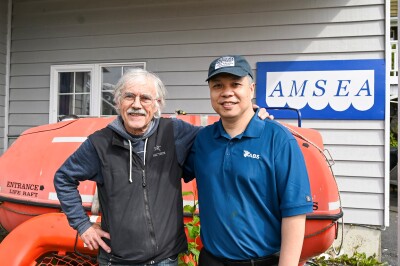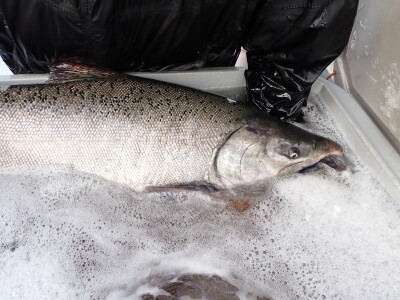Northeast
Maine shop lures Californians; historic schooner being rebuilt
California fishermen seem to have a thing for Down East lobster boat hulls.
Back in August 2007, RP Boat Shop was finishing up a 40-foot Willis Beal hull for a crabber in California. It was the second crabber that the Steuben, Maine, boatshop had sent to the Golden State.
Most people probably thought that was an anomaly, figuring it would be a long time before another California fisherman came to Maine to have a boat built and then trucked across the country.
But then Don Brockman, a Newport Beach, Calif.-based squid fisherman, came east to Steuben, went out on a couple of lobster boats built by RP Boat Shop to see how they handled and said, "I'll take two."
The first boat, the Little Viking, a 35-foot Willis Beal hull, was put on a trailer in August. The second boat, which will be a carbon copy of the first, is currently under construction.
The Little Viking resembles a Maine lobster boat with a couple of exceptions. There's a bow winch on the foredeck for anchoring, and in California, a 4-inch-diameter aluminum mast was set in place to hold a bank of lights.
Squid fishing takes place at night, and the lights are used to bring the squid to the surface. They operate off a 20-kW Northern Lights genset.
Underneath the plywood and fiberglass deck are two large baffled tanks with a combined holding capacity of 7 tons, says the boatshop's Richard Pinkham. Though he adds that most of the time, the boat probably won't carry more than 3 1/2 tons of squid.
The Little Viking doesn't catch squid, which is done by a larger seine boat, but transports squid from the bigger boat to an unloading dock, after they have been brailed from the seine into the holds.
Because of the weight the boat packs, Pinkham says the 450-hp Cummins QSM11, is situated 12 inches forward of where it would be in a lobster boat.
As might be expected, the hull was stiffened up a lot more than a lobster boat. The Little Viking has 2 x 10 stringers 20 inches on center. A lobster boat has the same size stringers, but they are 30 inches on center. The stringers are fiberglassed to the hull with four more layers of glass cloth than a lobster boat requires.
The squid tanks have 4 x 4 beams going around them that are locked into the floors, 2 x 6 deck beams, and the hull flange, which runs down the sides of the boat.
Up forward are a double V-berth, head and shower, and galley.
Pinkham says the Cummins diesel is matched up with a Twin Disc marine gear with a 2:1 reduction and a 26" x 30" prop. The boat makes 21 knots unloaded but probably not more than 10 knots when she is packing squid.
In Gloucester, Mass., restoration work continues on the 121' 6" x 24' 5" x 14' dory schooner Adventure.
Thomas McManus designed the Adventure, and she was built in 1926 at the John F. James & Son Shipyard in Essex, Mass. She was built as an auxiliary schooner with a 120-hp Cooper-Bessemer diesel and four sails. When the Adventure stopped fishing in 1953, she was the last American dory fishing schooner.
When the restoration work is completed, the schooner will be used as part of "an environmental education program focused on sustaining the fisheries and fishing communities. We hope the vessel will serve as a platform for bringing fishermen and other groups together," says Marty Krugman, president of Gloucester Adventure, the group behind the restoration process.
To date, $2.5 million has been spent restoring the hull, decks and cabin trunks. "We expect to spend $1.02 million more to complete the restoration," Krugman says. This is a historical restoration with every attempt made to use materials and building methods that would have been used when the boat was built.
The next phase of restoration calls for bulkheads to divide the interior into watertight compartments. Then restorers will install a fo'c'sle, galley, captain's cabin and ballast.
The work over the past 10 years has been done by Rose Marine in Gloucester and Scandia Marine in Tiverton, R.I.
If you want to donate to the cause, contact Gloucester Adventure, P.O. Box 1306, Gloucester, MA 01931; tel. (978) 281-8079. — Michael Crowley
West
Boatyard offers prefab houses; skiff features an unusual bow
If you have been fishing the Gulf of Alaska or Bering Sea this spring and summer, you know the weather has been anything but pleasant. "Snotty" would be a mild term.
"The guys would be happy if it would just blow 40," says Doug Alldridge at Yaquina Boat Equipment in Toledo, Ore.
Alldridge has seen firsthand the effects of the weather on some of the boats coming south from Alaska. "Boats that have been fishing there 15 to 20 years" are getting beat up, he says. One of those boats was the Blue Fox.
"The wave break was peeled back, and the deck peeled back like a can opener had been used," Alldridge says.
In another case, the 85-foot dragger Perseverance was in to have her bulwarks raised 43 inches to keep waves from slamming into the wheelhouse.
Alldridge says the problem "is that a lot of boats have been coming up here out of the Gulf of Mexico, and those boats are like submarines."
One of the southern-built boats was the Gold Rush, a 99-foot dragger out of Kodiak. Yaquina Boat Equipment gave the boat a new wheelhouse, and to get the house away from the waves, they reworked the bow and raised the deck 7 feet 6 inches.
Boats like the Gold Rush would tie up a lot of time and boatyard space if the crew had to build the wheelhouse after the boat arrived at the dock.
So seeing the toll the weather was taking on boats in Alaska, Yaquina Boat Equipment came up with a line of three standard-sized pilothouses for boats from 75 feet to 130 feet. These are prefabricated with wood trim, paneling and wiring before the boat even leaves the fishing grounds. When the boat arrives, the house is ready to be welded in place. It saves an immense amount of time and money, Alldridge says.
Over in Burlington, Wash., Stewart Everest at Everest Marine is completing oyster dredges just about as fast as he can build them to replace what he calls the "big, old wooden scows" that oyster companies have relied on for years.
He's working on the fifth 65-foot oyster dredge for Coast Seafoods Co., in Quilicene, Wash., and in August was laying the keel a second time for another oyster boat.
A few years ago, poor-quality aluminum plating was being sold to boatbuilders and creating a lot of problems. Ever since then, Everest says he's been "pretty wary of the material." That caution was a good thing, because after the first keel went down, Everest had progressed to plating up the engine room, bow plating was being pulled up, and the side sheets were going on "when I recognized there was a problem [with the aluminum]. Basically we had to take the boat all apart. We've done the initial process twice," he says.
In between the oyster boats, Everest Marine has a number of orders for aluminum skiffs. The design is something Everest developed in the 1980s for boats from 20 to 40 feet long. In the past, a number of the skiffs have gone to the herring industry. The ones he is building now are for the oyster industry.
The skiff has what Everest refers to as a "round bow." The bow sections are built by "rolling the bow sheets so it stays full width up to the peak. The bottom is a V-bottom that transfers up to a rounded bow plate. It's like a traditional hull until you look at it from the front," Everest says.
The deadrise in the skiff's V-bottom goes all the way up to where the deck is. Everest says the V-bottom gives the skiff the ability to plow through 3- to 4-foot chop.
The advantage in maintaining the boat's maximum beam all the way to the bow is increased carrying capacity.
The plating is finished off with a sheer cap of 2 1/2-inch pipe.
Everest figures a single outboard in the 200-hp range will work fine, but he's not sure what make it will be. "We did Hondas on the last ones, but we weren't sup
er impressed with them," he says. The outboard is mounted on an enclosed swim step on the transom. — Michael Crowley
South
An island boatyard stays busy; buy boats get museum passes
On Virginia's Tangier Island, Jerry Pruitt's boatyard, named — appropriately enough — Pruitt's Boatyard, is one of the busiest maintenance yards on Chesapeake Bay. The island is located in the middle of Chesapeake Bay, and everybody there seems to have a boat.
Pruitt's Boatyard has been extremely busy, as the yard is full of wood and fiberglass deadrise boats. Ordinarily, the island's fleet would be getting ready for the winter crab-dredging fishery. But Virginia's Marine Resources Commission voted this spring to eliminate the 100-year-old fishery, and now many of the boats will work the bay's oyster and gillnet fisheries.
Several island boats had been hauled on the railway. A new PVC guardrail was fastened on Ronnie Pruitt's deadrise workboat the Marilyn Rose. Peter Crockett's Logan Dean, a 42-foot deadrise workboat, and Wayne Wheatley's Miss Sandra were on the rails for routine maintenance.
"My yard manager, Gary Parks, does most of the painting, and I do most of the woodwork," Pruitt says.
"We don't have as many crabbers working the water, but this year has been one of the best crabbing seasons that we've seen in 30 years. I don't know how to explain it, but it's been good on Tangier," Pruitt says, referring to the crab potting and crab scrapping fisheries that close in the fall.
If there's a problem with Pruitt's Boatyard, it's that boats longer than 55 feet can't be hauled. Thus Pruitt has to go elsewhere to haul his own 60' x 18' 3" x 5' 4" Delvin K., one of only three Chesapeake Bay buy boats still operating commercially. He has used the boat for several years to plant seed oysters for the state of Virginia.
So in August, the Delvin K. was hauled out at the Chesapeake Bay Maritime Museum's railway in St. Michaels, Md.
The museum's boatyard manager, Richard Scofield, says the yard doesn't encourage non-museum work because the railway is there to maintain the museum's many wooden boats. However, Pruitt is an exception. "Jerry is a master craftsman, and he has helped us a great deal over the years," says Scofield.
From time to time, Pruitt has worked on the museum's boats in exchange for railway time for the Delvin K. and his other buy boat, the Island Star.
The Delvin K. is in top shape, but the Island Star has met the fate of so many of the bay's large wooden boats as she sits rotting on Tangier Island. The pilothouse is off the boat, lying nearby in the marsh, and the hull is open to the main killer of wooden boats — fresh water. There's just not enough commercial work to keep all the boats alive.
Scofield says Pruitt painted the Delvin K.'s fiberglass-covered wooden bottom, did routine maintenance work, and installed a shaft and cutlass bearing. The old stainless steel shaft was causing the prop to wobble slightly. It was replaced with a 2 1/2" x 12" stainless steel Aquamet shaft. The Delvin K. handles a 40" x 32" prop. "You need a sturdy shaft to handle that kind of wheel," Scofield notes.
The yard manager also says the Chesapeake Bay Maritime Museum likes to have traditional bay boats on the rails so visitors can see them out of the water.
While the Delvin K. was hauled out, seven ex-Chesapeake Bay buy boats came to St. Michaels after a weekend at Tangier Island, celebrating the island's 400th anniversary.
There were 17 boats at the Tangier Island gathering. It was the largest number seen together since the bay's commercial oyster fishery collapsed enough in the 1980s that the fishery couldn't support the large buy boats.
On a sad note in Maryland, Scofield reported that on Aug. 21, the longtime dean of Maryland's boatbuilders, Maynard Lowery, 88, of Tilghman Island was killed in an automobile accident in St. Michaels.
Lowery was a lifelong builder of wooden boats who started his career constructing deadrise fishing boats for island watermen. He progressed to yachts, and toward the end of his life specialized in small wooden sailing catboats.
"He knew the wooden boat craft as well as anyone alive," says Scofield. "It's a real tragedy. We are certainly going to miss him." — Larry Chowning






